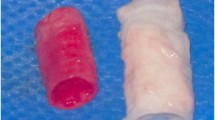Abstract
This study evaluated the possibility of tracheal reconstruction with allograft, pig-to-rabbit fresh xenograft or use of a tissue-engineered trachea, and compared acute rejection of three different transplanted tracheal segments in rabbits. Eighteen healthy New Zealand White rabbits weighing 2.5–3.1 kg were transplanted with three different types of trachea substitutes. Two rabbits and two alpha 1, 3-galactosyltransferase gene-knockout pigs weighing 5 kg were used as donors. The rabbits were divided into three groups: an allograft control group consisting of rabbit-to-rabbit allotransplantation animals (n = 6), a fresh xenograft group consisting of pig-to-rabbit xenotransplantation animals (n = 6), and an artificial trachea scaffold group (n = 6). All animals were monitored for 4 weeks for anastomotic complications or infection. The recipients were sacrificed at 28 days after surgery and the grafts were evaluated. On bronchoscopy, all of the fresh xenograft group animals showed ischemic and necrotic changes at 28 days after trachea replacement. The allograft rabbits and the tissue-engineered rabbits showed mild mucosal granulation. The levels of interleukin-2 and interferon-γ in the fresh xenograft group were higher than in other groups. Histopathologic examination of the graft in the fresh xenograft rabbits showed ischemic and necrotic changes, including a loss of epithelium, mucosal granulation, and necrosis of cartilaginous rings. The pig-to-rabbit xenografts showed more severe acute rejection within a month than the rabbits with allograft or artificial trachea-mimetic graft. In addition, the artificial tracheal scaffold used in the present experiment is superior to fresh xenograft and may facilitate tracheal reconstruction in the clinical setting.






Similar content being viewed by others
References
Nakanishi R. Revascularization of trachea in lung and tracheal transplantation. Clin Transpl. 2007;21:668–74.
Ekser B, Gridelli B, Tector AJ, Cooper DK. Pig liver xenotransplantation as a bridge to allotransplantation: which patients might benefit? Transplantation. 2009;88:1041–9.
Neville WE, Bolanowski PJ, Kotia GG. Clinical experience with the silicone tracheal prosthesis. J Thorac Cardiovasc Surg. 1990;99:604–13.
Trojan I, Kecskes L, Vecsei B, Bense S, Brzozka M, Ordögh B, et al. Tracheal substitution in dogs with reinforced Gore-Tex prosthesis. Thorac Cardiovasc Surg. 1985;33:337–40.
Nelson RJ, Goldberg L, White RA, Shors E, Hirose FM. Neovascularity of a tracheal prosthesis/tissue complex. J Thorac Cardiovasc Surg. 1983;86:800–8.
Cleven HA, Genden EM, Moran TM. Reepithelialized orthotopic tracheal allografts expand memory cytotoxic T lymphocytes but show no evidence of chronic rejection. Transplantation. 2005;79:861–8.
Delaere PR, Liu ZY, Hermans R, Sciot R, Feenstra L. Experimental tracheal allograft revascularization and transplantation. J Thorac Cardiovasc Surg. 1995;110:728–7.
Park JH, Park JY, Nam I-C, Hwang S-H, Kim C-S, Jin WJ, Jinah J, Hyungseok L, Yeongjin C, Sun HP, Sung WK, Dong-Woo C. Human turbinate mesenchymal stromal cell sheets with bellows graft for rapid tracheal epithelial regeneration. Acta Biomater. 2015;25:56–64.
Hwang SH, Kim SY, Park SH, Choi MY, Kang HW, Seol YJ, Park JH, Cho DW, Hong OK, Rha JG, Kim SW. Human inferior turbinate: an alternative tissue source of multipotent mesenchymal stromal cells. Otolaryngol Head Neck Surg. 2012;147:568 – 74.
Lu L-J, Sun J-B, Liu Z-G, Gong Xu, Cui J-L, Xi-Guang S. Immune responses following mouse peripheral nerve xenotransplantation in rats. J Biomed Biotechnol 2009. https://doi.org/10.1155/2009/412598. http://www.hindawi.com/journals/bmri/2009/412598/. Accessed 24 July 2009.
Fox IK, Jaramillo A, Hunter DA, Rickman SR, Mohanakumar T et al. Prolonged cold-preservation of nerve allografts. Muscle Nerve. 2005;31:59–69.
Crikis S, Cowan PJ, d’Apice AJ. Intravascular thrombosis in discordant xenotransplantation. Transplantation. 2006;82:1119–23.
Hashimoto M, Nakanishi R, Umesue M, Hachida M, Yasumoto K. Feasibility of cryopreserved tracheal xenotransplants with the use of short-course immunosuppression. J Thorac Cardiovasc Surg. 2001;121:241–8.
Shimizu A, Yamada K. Pathology of renal xenograft rejection in pig to non-human primate transplantation. Clin Transpl. 2006;20:46–52.
Cooper DK, Gollackner B, Sachs DH. Will the pig solve the transplantation backlog? Annu Rev Med. 2002;53:133.
Sachs DH, Sykes M, Robson SC, Cooper DK. Xenotransplantation. Adv Immunol. 2001;79:129–223.
Cascalho M, Ogle BM, Platt JL. Xenotransplantation and the future of renal replacement. J Am Soc Nephrol. 2004;15:1106–12.
Platt JL, Lin SS. The future promises of xenotransplantation. Ann NY Acad Sci. 1998;862:5–18.
Sandrin MS, McKenzie IF. Recent advances in xenotransplantation. Curr Opin Immunol. 1999;11:527–31.
McGregor CG, Teotia SS, Byrne GW, Michaels MG, Risdahl JM, Schirmer JM, et al. Cardiac xenotransplantation: progress toward the clinic. Transplantation. 2004;78:1569–75.
Tai HC, Ezzelarab M, Hara H, Ayares D, Cooper DK. Progress in xenotransplantation following the introduction of gene-knockout technology. Transpl Int. 2007;20:107–17.
Acknowledgements
This work was supported by the Industrial Technology Innovation Program (No.10048358) funded by the Ministry Of Trade, Industry Energy (MI, Korea) and Basic Science Research Program through the National Research Foundation of Korea (NRF) funded by the Ministry of Education (No. 2017R1A6A3A11035222).
Author information
Authors and Affiliations
Corresponding author
Ethics declarations
Conflict of interest
The authors declare that they have no conflict of interest.
Rights and permissions
About this article
Cite this article
Lee, J.Y., Park, J.H. & Cho, DW. Comparison of tracheal reconstruction with allograft, fresh xenograft and artificial trachea scaffold in a rabbit model. J Artif Organs 21, 325–331 (2018). https://doi.org/10.1007/s10047-018-1045-2
Received:
Accepted:
Published:
Issue Date:
DOI: https://doi.org/10.1007/s10047-018-1045-2




